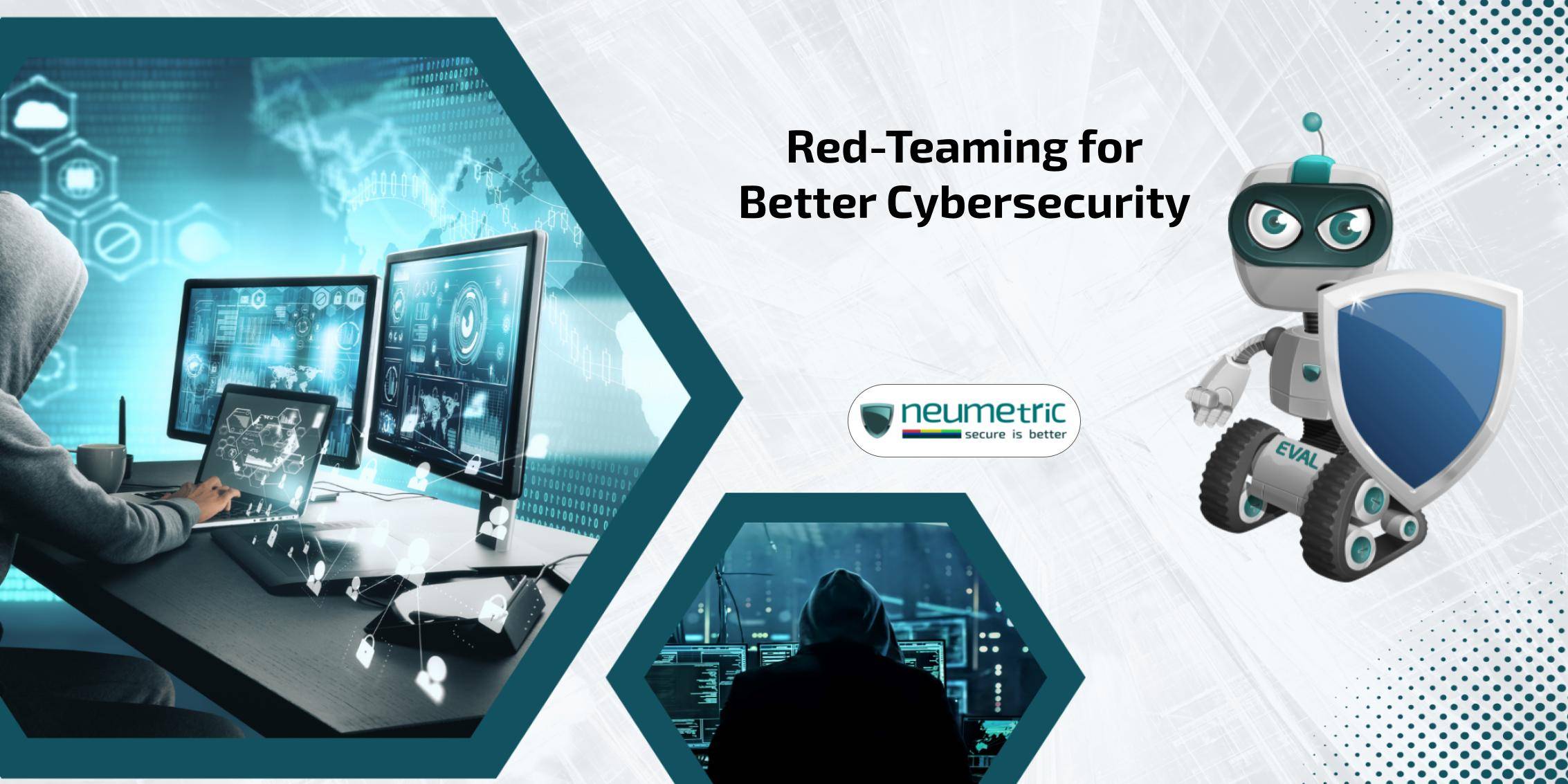Table of Contents
ToggleRed-Teaming for Better Cybersecurity
Introduction
In an era where digital landscapes are constantly evolving, organizations face unprecedented cybersecurity challenges. From sophisticated cyber threats to rapidly advancing technologies, the need for robust security measures has never been more critical. Red-teaming is a proactive cybersecurity strategy designed to emulate the tactics of potential adversaries. Unlike traditional approaches that focus on defense, it involves simulating real-world cyber attacks, providing organizations with a unique perspective on their vulnerabilities.
Red-teaming goes beyond routine security assessments. It actively seeks out weaknesses in existing defenses by employing the same strategies a malicious actor might use. This approach allows organizations to identify & address vulnerabilities before cybercriminals can exploit them, ultimately fortifying their cybersecurity posture.
Understanding Red-Teaming
It involves a team of experts, the red team, simulating cyber attacks to identify vulnerabilities & weaknesses in an organization’s defenses. Picture it as a friendly but intense game of cat & mouse, with the red team playing the role of the elusive mouse, keeping the defenders on their toes.
Distinction from Traditional Cyber Security Approaches: Now, here’s where red-teaming puts on a different hat compared to traditional cybersecurity. While traditional approaches focus on building a strong defense – fortifying the castle walls, so to speak – it takes a more offensive stance. It’s not about just shoring up the walls; it’s about sending in a stealthy force to actively probe & find the weak points before the enemy does. It’s less about playing defense & more about outsmarting potential attackers by thinking like them.
Evolution of Red-Teaming in the Cybersecurity Landscape: Picture it as a digital chameleon, adapting to the changing colors of the cybersecurity landscape. It didn’t start in the digital age but has evolved alongside it. Originally rooted in military simulations, it has transformed into a dynamic cybersecurity strategy. With the rise of sophisticated cyber threats, the role of red-teaming has become increasingly crucial. It’s not just a one-time exercise; it’s an ongoing process that continually refines its techniques to stay ahead of emerging threats. Red-teaming has become a key player in the cybersecurity chessboard, evolving to face the challenges of the digital frontier.
Benefits of Red-Teaming
One of the primary advantages of red-teaming is its ability to proactively identify potential threats. That’s the essence of red-teaming’s proactive threat identification. By simulating realistic cyber attacks, organizations can spot vulnerabilities before malicious actors do. It’s a bit like getting a heads-up before the storm hits, allowing for strategic reinforcement of defenses & minimizing the element of surprise.
Improved Incident Response Preparedness: In the world of cybersecurity, it’s not a matter of if but when an incident will occur. Red-teaming serves as the ultimate dress rehearsal for the security team. By subjecting systems to simulated attacks, teams refine their incident response strategies. It’s like practicing fire drills – the more you practice, the smoother & more effective your response becomes. Red-teaming ensures that when a real incident occurs, the organization is not caught off guard but responds with agility & precision.
Enhanced Overall Cybersecurity Posture: The insights gained from red-teaming contribute to a holistic improvement of an organization’s cybersecurity posture. By actively identifying & addressing vulnerabilities, it’s like giving the digital fortress a solid upgrade. Each simulated attack becomes a building block, strengthening the defense against a wide array of potential threats. The result is not just better security; it’s a comprehensive & resilient cybersecurity posture that stands the test of time.
Cost-Effectiveness in the Long Run: Investing in cybersecurity is often seen as a hefty expense, but red-teaming flips the script by being a cost-effective long-term solution. Yes, there’s an upfront investment, but consider it an insurance policy against potential cyber disasters. By proactively identifying & mitigating threats, organizations can avoid the financial & reputational fallout of a real cyber attack. It’s like fixing a leaky roof before the storm – a small investment now that saves from a major financial downpour later.
Key Components of an Effective Red-Teaming Framework
Think of red-teaming methodologies as the blueprints for a cybersecurity strategy. Different approaches cater to different needs. Whether it’s adversary emulation, threat intelligence-driven testing or a combination of both, the chosen methodology sets the tone for the entire operation. It’s the roadmap that guides red teamers in their mission to uncover vulnerabilities. Organizations need to carefully select or tailor methodologies to align with their unique challenges & objectives.
Simulation Tools & Technologies: The arsenal of a red team is incomplete without cutting-edge simulation tools & technologies. These are the weapons in their arsenal, allowing them to realistically emulate cyber threats. From penetration testing tools to advanced threat emulation platforms, the selection of tools is critical. It’s not just about having the latest gadgets; it’s about having the right ones that complement the chosen methodologies. The effectiveness of the simulation hinges on the quality & relevance of these tools.
Role of Skilled Professionals in Red-Teaming: Red-teaming is not just about tools; it’s about the skilled professionals behind them. Skilled professionals, often referred to as red teamers, are the virtuosos orchestrating the cybersecurity assessment. Their diverse backgrounds in cybersecurity, coupled with a blend of creativity & expertise, make them the backbone of red-teaming. It’s not just about running automated tests; it’s about the human touch, the ability to think like an attacker & identify unconventional vulnerabilities. Investing in training & retaining top-tier talent is paramount for the success of any red-teaming initiative.
Collaboration with Internal & External Stakeholders: Red-teaming is not a solo act; it’s a collaborative performance. Internal stakeholders, from IT personnel to executives, play crucial roles. Their insights provide context & depth to the assessment. External collaboration, whether through partnering with external red teams or engaging with threat intelligence providers, injects fresh perspectives. It’s like assembling a diverse team of experts, each bringing a unique skill set to the table. Collaboration ensures a comprehensive evaluation that considers both internal intricacies & external threat landscapes.
In the grand theater of cybersecurity, an effective red-teaming framework is the well-rehearsed play that keeps the audience engaged & the actors sharp. Methodologies guide the plot, simulation tools set the stage, skilled professionals deliver the performance & collaboration with stakeholders ensures a seamless production. It’s not just a checklist; it’s the composition of elements that transforms red-teaming from a routine exercise into a strategic masterpiece.
Challenges in Implementing Red-Teaming
Implementing red-teaming often faces the uphill battle of overcoming resistance. Teams comfortable with routine security measures might see red-teaming as a disruption or an unnecessary shake-up. The key lies in communication & education – making everyone aware that red-teaming isn’t about dismantling the old but fortifying it with a proactive layer. It’s not just change for change’s sake; it’s about staying ahead of the curve in an ever-evolving digital landscape.
Addressing Resource Constraints: In the world of red-teaming, resources are the fuel that keeps the engine running. Skilled professionals, cutting-edge tools & time are essential & yet, organizations often grapple with resource constraints. It’s like planning a grand feast with limited ingredients. Prioritization becomes the name of the game. While addressing resource constraints, organizations must strategically allocate what they have, focusing on critical assets & gradually expanding their red-teaming capabilities as resources allow.
Balancing Realism & Potential Impact on Operations: Red-teaming aims for realism, but there’s a fine line between realistic simulations & causing chaos in operations. The challenge is to strike a delicate balance. Simulations need to mirror potential threats without triggering unnecessary panic or disruption. It’s like practicing a fire drill – you want it to be realistic enough to prepare, but not so intense that everyone starts sprinting for the exits. Collaboration with internal stakeholders becomes paramount, ensuring that red-teaming remains a controlled exercise with minimal operational impact.
It’s about navigating resistance, strategically managing resources & finding the equilibrium between realism & operational impact. Each challenge is an opportunity for growth, learning & ultimately, strengthening an organization’s cybersecurity resilience. After all, in the ever-changing world of cybersecurity, challenges are not roadblocks; they’re the stepping stones to a more robust defense strategy.
Human Factors in Red-Teaming
Ever wonder what goes on in the minds of cyber attackers? It’s a psychological chess game & red-teaming brings you a front-row seat. By understanding the motives, tactics & strategies of potential adversaries, red teamers get into the psychology of cyber threats. It’s not just about the code; it’s about decoding the human element behind the attacks. This insight enables a more realistic simulation of threats, ensuring that our defenses are fortified against the unpredictable maneuvers of malicious actors.
Behavioral Analysis in Cybersecurity Assessments: In the world of cybersecurity, it’s not just about the ones & zeros; it’s about how humans interact with the digital realm. Behavioral analysis in red-teaming assessments puts a spotlight on the human factor. How do employees respond to phishing attempts? Are they following security protocols? By observing & analyzing human behavior, red teamers identify vulnerabilities that might go unnoticed in purely technical assessments. It’s a holistic approach that recognizes the pivotal role of people in the cybersecurity equation.
Continuous Improvement through Red-Teaming
Cyber threats are shape-shifters & red-teaming is the chameleon of cybersecurity strategies. It embraces the iterative dance required to stay ahead of evolving threats. It isn’t a one-off performance; it’s a series of acts in a dynamic play. The landscape changes, new threats emerge & red teamers adapt. It’s a continuous loop of testing, learning, adjusting & testing again. This iterative nature ensures that our defenses evolve in sync with the ever-shifting digital battleground.
Adapting Cybersecurity Strategies Based on Red-Teaming Insights: Insights from the exercises aren’t just data points; they’re the compass guiding the ship through the stormy seas of cyber threats. Adapting cybersecurity strategies based on these insights is the essence of continuous improvement. If a simulated attack reveals a vulnerability, it’s not just patched; it triggers a strategic reassessment. Maybe it’s a tweak in protocols, an investment in new technologies or a shift in employee training. The insights shape a proactive, adaptive cybersecurity strategy that’s always one step ahead.
In the ever-evolving game of cybersecurity, where human ingenuity meets digital threats, red-teaming stands as a dynamic force. It’s not just about understanding the psychology of attackers; it’s about anticipating their next move. It’s not just about iterative testing; it’s about evolving with the threat landscape. This isn’t just a strategy; it’s a mindset – one that ensures our digital defenses are not just strong but continuously getting stronger.
Conclusion
In a digital landscape where cyber threats are as diverse as they are sophisticated, embracing red-teaming is not just a choice; it’s a strategic imperative. It’s about adopting a mindset of continuous improvement, where staying one step ahead of potential threats becomes ingrained in the organizational culture. It is not merely a box to check; it’s a commitment to ongoing enhancement.
The landscape will only become more intricate, with new technologies & attack vectors constantly emerging. Red-teaming, with its holistic approach encompassing technology, human behavior & strategic insights, is poised to be at the forefront of safeguarding digital domains. It’s not just a tool; it’s a philosophy – a recognition that in the ever-evolving game of cybersecurity, proactive & continuous improvement is the key to staying ahead of the curve. Embrace red-teaming & the future will be a more secure, resilient & adaptive cybersecurity landscape.
FAQ
Why is it important to understand the psychology of cyber attackers in red-teaming?
Understanding the psychology of cyber attackers is crucial because it adds a human element to our defense strategies. It’s not just about anticipating the technical moves; it’s about getting into the minds of potential adversaries. By doing so, red teamers can simulate attacks more realistically, considering not just the how but also the why behind cyber threats. This insight helps organizations better prepare for & counteract the nuanced strategies employed by malicious actors.
How does red-teaming contribute to continuous improvement in cybersecurity?
It is like a fitness regimen for cybersecurity – it’s all about getting stronger over time. The iterative nature of red-teaming ensures that our defenses evolve with the ever-changing threat landscape. Regular assessments provide a continuous feedback loop, offering insights into vulnerabilities, behavioral patterns & the effectiveness of existing security measures. This data becomes a roadmap for adapting & enhancing cybersecurity strategies, making the entire system more resilient against emerging threats.
What sets red-teaming apart from traditional cybersecurity approaches & why is it gaining prominence?
This stands out because it’s not just about building a strong defense; it actively tests that defense by simulating real-world attacks. Traditional cybersecurity approaches focus on prevention, while red-teaming embraces a proactive stance, anticipating & addressing vulnerabilities before they are exploited. It’s gaining prominence because in the rapidly evolving digital landscape, organizations need more than static defenses – they need a dynamic & adaptive strategy. It offers precisely that, helping organizations stay ahead of emerging cyber threats.





